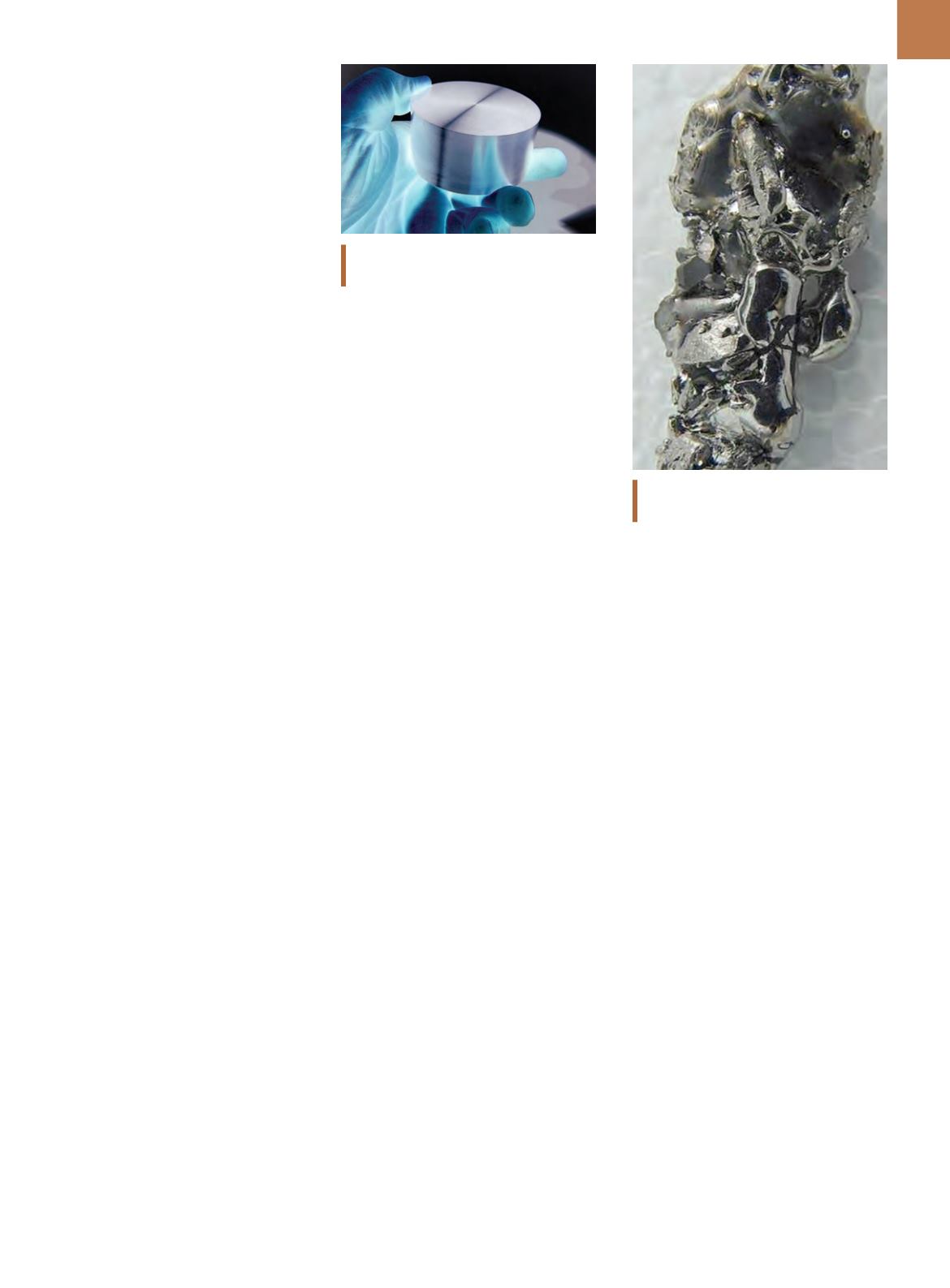

A D V A N C E D
M A T E R I A L S
&
P R O C E S S E S |
M A R C H
2 0 1 5
3 1
his invention. His process involved a
modification of the sodium reduction
of titanium tetrachloride used by Mat-
thew Hunter at General Electric Corp.
in the early 1900s. Kroll, however, used
magnesium instead of sodium as the
reducing agent. The resulting metallic
product was a spongelike collection
of particles that required removal of
residual magnesium and magnesium
chloride contaminants. After cleaning,
the sponge was crushed to powder,
compacted, and heated at a high tem-
perature to sinter it into a solid mass.
BUREAU OF MINES RESEARCH
The U.S. Bureau of Mines (BOM)
began investigating Kroll’s process at
the Salt Lake City Experimental Station
duringWWII. Titaniumwasmade in 15-lb
batches by 1944. The first steps beyond
the BOM work occurred in 1946 when a
contract was awarded to Battelle Memo-
rial Institute in Columbus, Ohio, to study
the properties, welding, and fabrication
characteristics of titanium and its alloys.
BOM supplied the titanium, with funding
covered by the U.S. Air Force by way of
Douglas Aircraft Co. Every branch of the
armed forces—as well as all government
agencies with an interest in this new
metal—eagerly followed the research
work at Battelle through its progress
reports. This was the first broad scope,
independent research to evaluate titani-
um’s practical capabilities.
After a two-year study, a final clas-
sified report was issued in 1948 con-
cluding that titanium and its alloys had
great engineering potential and further
development should be pursued. This
report and other evidence from work
at the BOM, Wright-Patterson Air Force
Laboratory, and the Army Ordnance
Dept. at Watertown Arsenal provided
the foundation for promoting a new in-
dustry based on titanium. E.I. du Pont
de Nemours and Co. (DuPont) was the
first commercial organization to com-
mit resources to producing titanium. In
late 1948, DuPont sold titanium sponge
for $5 per lb from its production of 100
lb per day. The Remington Arms division
of DuPont conducted research on metal
made from this sponge and would later
be amajor partner in producing titanium
for the aerospace market.
Titanium strips inside a glass jar. Courtesy
of Wikimedia Commons.
A titanium cylinder. Courtesy of Wikime-
dia Commons, Alchemist-hp.
FIRST TITANIUM CONFERENCE
The first major conference on tita-
niumwas held in Washington on Decem-
ber 16, 1948. It was organized by Nathan
Promisel of the Navy’s Bureau of Aero-
nautics and Julius Harwood of the Office
of Naval Research, and held at the Na-
tional Academy of Sciences. Thismeeting
is considered titanium’s official debut.
Many factors came together at this time
that influenced all levels of government
to cooperate in this endeavor. All through
WWII there were shortages of certain ma-
terials vital to the war effort. Metals such
as tungsten, nickel, chromium, manga-
nese, and others were controlled by the
War Production Board and released on
priority bases for only the most import-
ant applications. The initiation of Korean
hostilities in June 1950 provided addi-
tional incentive to develop a new metal
withsuchpromisingproperties and ready
availability in the U.S. It was believed at
this time that the U.S. was self-sufficient
in rutile, the major ore of titanium.
When sample quantities of BOM
material became available, they were
distributed to interested laboratories
across the country including those of
the Army, Navy, and Air Force, as well as
some industrial companies, such as the
National Lead Co. and Kennecott Copper
Co. Studies revealed properties of imme-
diate interest, notably corrosion resis-
tance and strength. It was further sug-
gested that titanium might replace both
aluminum and steel in many defense
applications. Enthusiasm for titanium
reached the highest levels at the Depart-
ment of Defense where funding was ob-
tained for further research and develop-
ment. One of the earliest studies in the
search for alloys with superior mechan-
ical properties was the Rand Program
of the Air Force Materiel Command. This
program financed a laboratory project
at Battelle Memorial Institute to study
a wide range of alloy additions for their
effect on both the physical and mechan-
ical behavior of titanium.
STEEL INDUSTRY INTEREST
Several steel producers
began to
show interest in titanium including Al-
legheny Ludlum Corp., Crucible Steel
Co., Republic Steel Corp., and Sharon
Steel Co. These companies were attract-
ed to titanium for its excellent properties,
which might be exploited as new busi-
ness, and also because titanium could
become a serious competitor to their
regular business, stainless steel. During
1949-1950, they bought titanium sponge
from DuPont and turned it into bar and
sheet products. Thematerial was primar-
ily used for testing by various defense
laboratories, universities, and industrial
firms. National Lead Co. came on stream
in 1950 as a second producer of sponge,
taking over sponge production through
a contract with the BOM at the Boulder
City Experimental Station in Nevada. A
newmetals industry was about to form.
For more information:
Charles R.
Simcoe can be reached at
crsimcoe1@gmail.com.

















